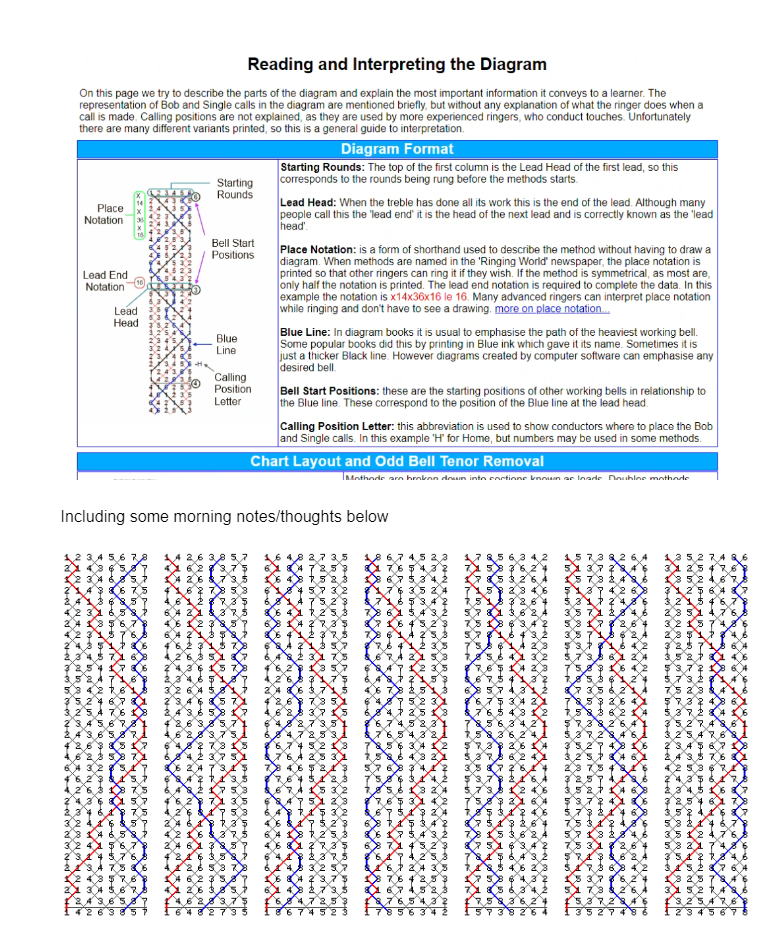created, $=dv.current().file.ctime & modified, =this.modified
NOTE
Bell-ringing - involved and complex. Woven, and feels like some computation of sound.
These are remnants of research for trying to think of some connections or an application. The discourse around this art is beautiful.
It’s also a mixture of the mundane and the perceived holy.
My confusion parsing the diagrams was also an attraction.
Thoughts on the art:
Divorced from religion, became exercise and sport.
The force of the instrument can destroy. Tower oscillation, force of two tons of weight throwing into the bell tower - self destructive. Brick towers can wobble if uncareful.
“Change ringing” - method where a change pushes down the line, order shifting
You have to be able to see your partners all at once, to see who you follow. This is interesting, it must be a circle of participants, all who see themselves. The above is called “ropesight”
The bell ringers are hidden (sometimes deep below, zero visible performance), and occasionally the bells are also hidden. Cathedral ringing - more complex as the bells are heavy.
Ding Dong - a single bell is binary.
Bottoms of ropes are looped to avoid catching on feet, hung radially to stifle movement.
The bells themselves, are tons of weight, that hang above the players heads, tempted to drop.
The stay is a generally wooden part that serves to obstruct the full rotation of the bell. It can break, and is wood so that it mitigates damage to the whole unit.
So I have this old project, which involved “sound creatures” (I later read The Preserving Machine)
NOTE
I do see a possible avenue as these “bell” diagrams being a kind of individualized code for these sound creatures. I like these nonobvious methods. Like I imagine a room with all of these hidden codes, like a bombardment of them that you have to filter out (different lights “speaking” in rhythms, flags with other text - like two red socks on a clothesline meaning “love you, but danger”). Literally packed with hidden words. You’d read by learning to see. You’d need special headphones to tap into the small beeps. Like a space that is devoid of “alphabet” characters, but still speaking, ebbing.
Back in college I was into Processing and Unity and had just read the short story “The Preserving Machine” by Philip K Dick. It’s a weird story like most PKD ones. The basic premise as much as I can recall is the earth is in a state of collapse, and it cannot sustain works of art (Imagine an art gallery in a nuclear war, might not be a priority). This doctor fears for pieces of art, particularly music.
So he creates this machine that preserves musical scores into creatures, like bugs or animals, that are capable of living and defending themselves. You’ll have to read the story but he finds that playing them back they have begun to evolve and alter the original scores.
So my idea with processing was to try to make that and I made a rough concept. It’d be a cool project to revisit. I was just thinking along the lines of a creature that would be made only of sound, and not have a physical body. You could have a sample of music, MIDI or whatever even sample, as the core or DNA of the creature and then the interaction of the different creatures would alter the songs they produce.
The bell DNA. Kind of like a kid when you get bugs in a jar, and then they live, maybe you forget it and come back and you have this surprise generated song that resulted from the interactions in the environment. I guess those kind of projects are dominated by machine learning these days. I’m sure there are better ones out there The idea was kind of like viewing a pond from above, and you have these invisible music creatures below the surface (maybe even some wet audio reverb or something) and you probe the top of the pool with your instrument, and can here the different interacting sound creatures below the surface singing and learning
Involved languange:
Example: A composition might be advertised as being ‘true to BDEKacdefYZ’. A band is considering using this composition to ring Othorpe Surprise Major. The CC Methods Library shows that the false coursehead groups for Othorpe are BDXY. Because Othorpe has group X falseness but the composition does not include X in the list of groups that it is true to, this composition will be false if used with Othorpe. Methods without any in-course false courseheads are referred to as “cps”, or clear proof scale. However, these methods will usually have out-of-course false courseheads. Bristol Surprise Major is an example of a cps method. A method that is false in the plain course will have false coursehead group A, usually in addition to other groups. https://framework.cccbr.org.uk/version2/falsecourseheads.html
Seems like they are cataloging the entire possibilty space of bells and naming them…


Some of the bell spaces have a surreal office feeling to them, or feel like a space that is multipurpose

